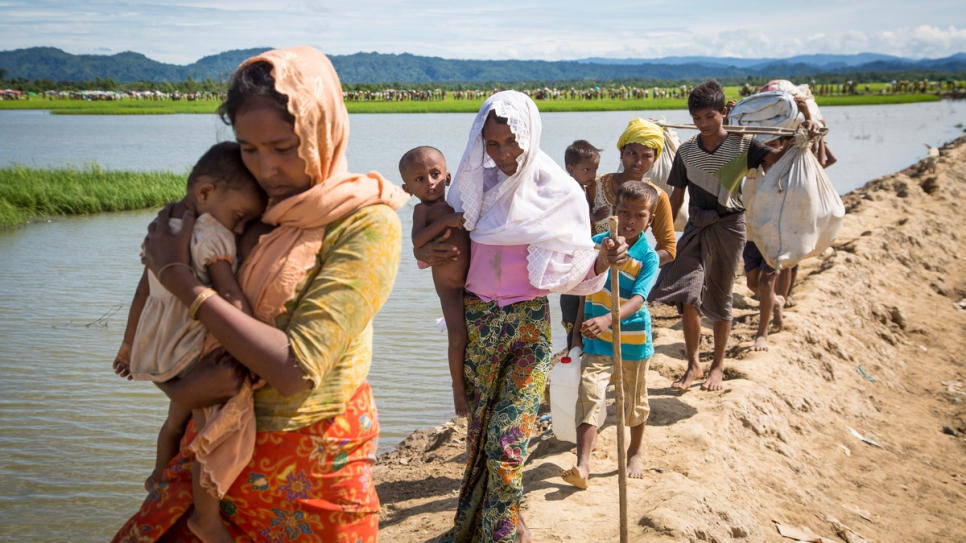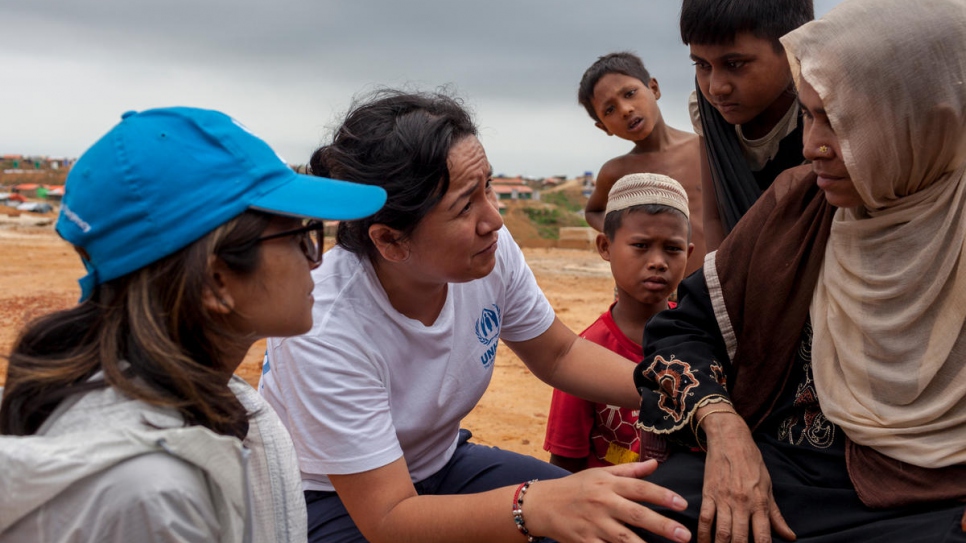Rohingya refugees mark a year of suffering and hope
More than 720,000 children, women and men have fled violence that erupted in Myanmar on August 25 last year. They remain in need of solutions a year on.
A Rohingya mother carries her baby through a paddy field on the Bangladesh-Myanmar border.
© UNHCR/Roger Arnold
With villages in flames in northern Myanmar, Tahara grabbed her four-month old baby and set out under the monsoon downpour in a desperate search for safety in Bangladesh.
“We were stuck under the rain,” the Rohingya mother recalls. “We had to hide under a tree in the hills for two nights. All I had was some stale rice. I have a little baby who needs milk.”
One year ago, on 25 August 2017, violence in Rakhine State, Myanmar, set off a new wave of destruction and fear that pushed more than 720,000 refugees – more than half of them children – into the Cox’s Bazar district of Bangladesh.
At the height of the influx, tens of thousands of refugees like Tahara and her baby were arriving in Bangladesh each day, in one of the fastest growing refugee crises in years. Within a month, nearly 500,000 children, women and men had fled over the border, the pall of smoke from scores of smouldering villages visible from Bangladesh.
Many hiked for days through the Mayu Mountains that divide Rakhine State, or paddled makeshift rafts across the Naf River, the natural boundary between Bangladesh and Myanmar. Some even swam. Women reached Cox’s Bazar heavily pregnant, men with gunshot and knife wounds. Among the most vulnerable were the children separated from their parents, and families carrying older relatives with bamboo poles.
Like almost all the refugees in Bangladesh, Tahara is Rohingya, a stateless Muslim minority from Myanmar long subject to discriminatory laws and policies that deny them citizenship, basic rights and the chance to lead normal, dignified lives. She and her baby were among the first to arrive in Bangladesh, bartering jewellery and other belongings to the boatmen who ferried them from Myanmar.
“We had to cross with a boat so I paid money. I also had to give my earrings,” she says.

Rohingya crisis, one year on: Ensuring lifesaving support for mothers and children (Videographer and editor, Viktor Pesenti)
As waves of refugees stumbled into the Kutupalong and Nayapara areas under the rain, exhausted, emaciated and in need of food, water and shelter, Bangladeshis were the first to respond. The government kept its border open and launched mass vaccinations of children, while citizens mobilized aid drives for the refugees.
Cars, trucks and buses rolled in from across the country, as factory workers, business associations and religious groups brought life-saving rice, dahl and bottled water, as well as clothing and tarpaulins, distributing them to refugees lined up in the mud. In Cox’s Bazar district, smallholders also gave land for refugees to build temporary shelters and start over.
“At the very beginning, the local community opened their hearts,” recalls Anupam Das Anup, one of the Bangladesh government’s deputy Camps-in-Charge in Cox’s Bazar. “They saved the most lives.”
To support the government, international organizations stepped up their response – fast. By the end of September, UNHCR, the UN Refugee Agency, had doubled its staff in Cox’s Bazar and immediately airlifted more than 1,500 metric tons of emergency life-saving aid to Bangladesh – including blankets, plastic sheets, sleeping mats, tents and cooking items.
“They have absolutely nothing,” UN High Commissioner for Refugees Filippo Grandi stressed during a visit to Cox’s Bazar in September. “I have hardly seen in my career people that have come with so little. They need everything.”
Within weeks, a vast spontaneous settlement had sprung up over the hillsides around Kutupalong, with a population greater than Lyon, France’s third largest city, raising concerns over the lack of adequate shelter, water and sanitation, access to basic services, and the safety of women and girls. With the risk that outbreaks of disease might cause a “disaster within a disaster,” UNHCR and its partners added thousands of latrines, and dug tube wells and bore holes to provide clean water.
Adding clinics and medical centres, UNHCR sought to contain outbreaks ranging from acute watery diarrhoea to measles and diphtheria, helped by round-the-clock outreach efforts by refugee community volunteers. From the first weeks of the emergency, medical staff also brought mental health first aid to refugees who had witnessed unimaginable horrors and loss.
In the months that followed, new information points advised residents on services that are available. These include learning centres, providing basic literacy, life skills and maths, and child and women friendly spaces, supported by UN agencies and NGO partners. Other activities include occupational training, such as learning to sew, make toothpowder or soap, provided by local NGO BRAC.
“I like to sew and I need an income,” says Laila Begum, 25, a single parent who attends a sewing workshop which teaches dozens of women to make fishing nets and prayer caps to sell.
As the monsoon season loomed in Bangladesh, one of the most natural disaster-prone countries in the world, UNHCR and its partners raced against time to safeguard refugees in precarious hillside settlements, where some 200,000 people were in areas prone to landslides and flooding.
With no municipal works department to fortify what is now effectively Bangladesh’s sixth-largest city, UNHCR joined forces with the World Food Programme and International Organization for Migration deploy engineers and earth movers throughout the settlement to repair damaged roads, clear drainage and landslides, and stabilize compromised slopes.
The refugees themselves worked around the clock to strengthen their shelters and, in some areas, flatten whole hills to build new, safer shelters. With support from engineers and the Bangladesh military, refugees have helped build or repair over two kilometres of bridges, 32 kilometres of road, 45 kilometres of steps, 63 kilometres of retaining structures and 91 kilometres of drainage.
“We used to walk through the mud,” says refugee Hafiz, 30, as he recently took a break from rebuilding a bamboo bridge that is one of the main arteries into Kutupalong. When he first arrived from Myanmar in October, after a 14-day journey past dead bodies, there was still a shortage of water points available to refugees, and he drew water from canals, not knowing their source. “Now we have bridges, better toilets, more food and drinking water,” he said.
The efforts by Hafiz and others have allowed 24,000 refugees to be relocated to safer areas, away from flooding and landslides, and prevented untold fatalities.
“Now we have bridges, better toilets, more food and drinking water."
At the one-year mark, the humanitarian response in Bangladesh remains focused on meeting the massive humanitarian needs of the refugees, whose numbers have been growing at a much slower pace in recent months, with 12,000 new arrivals since January.
More donor support is needed for a key US$951 million humanitarian aid plan, to continue delivering lifesaving assistance through the end of the year. As of early August, it remains just 33 per cent fund.
The aim remains the voluntary return of refugees to their homes in Myanmar, when conditions there allow for them do so safely, in dignity, and sustainably. UNHCR is working with Myanmar authorities on creating these conditions in Rakhine State. But substantial progress is still needed in addressing the root causes of the crisis, including freedom of movement, safety and a pathway to citizenship for all communities.
In the meantime, more international support is urgently needed to step up the assistance in Bangladesh from purely humanitarian and day-to-day support towards addressing medium-term challenges – namely providing livelihoods, education, registration, programmes for the most vulnerable – children, women and older people.
For community health volunteer Kurshida, the chance to gain a formal education would be transformational. “We are qualified people,” she says. “We want to develop our education, so that we have the power to speak for ourselves.”
Reporting by Keane Shum, Roger Burks and Viktor Pesenti in Cox’s Bazar, Bangladesh.












